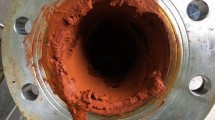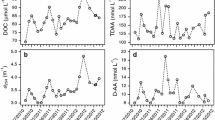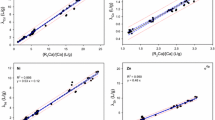Abstract
Dialysis and chemical speciation modelling have been used to calculate activities of Fe3+ for a range of UK surface waters of varying chemistry (pH 4.3–8.0; dissolved organic carbon 1.7–40.3 mg l−1) at 283 K. The resulting activities were regressed against pH to give the empirical model: \( \log \,a_{{{\text{Fe}}^{3 + } }} = 2.93\left( { \pm 0.40} \right) - 2.70\left( { \pm 0.06} \right) \cdot {\text{pH}} \). Predicted Fe3+ activities are consistent with a solid–solution equilibrium with hydrous ferric oxide, consistent with some previous studies on Fe(III) solubility in the laboratory. However, as has also sometimes been observed in the laboratory, the slope of the solubility equation is lower than the theoretical value of 3. The empirical model was used to predict concentrations of Fe in dialysates and ultrafiltrates of globally distributed surface and soil/groundwaters. The predictions were improved greatly by the incorporation of a temperature correction for \( a_{{{\text{Fe}}^{{ 3 + }} }} \), consistent with the temperature dependence of previously reported hydrous ferric oxide solubility. The empirical model, incorporating temperature effects, may be used to make generic predictions of the ratio of free and complexed Fe(III) to dissolved organic matter in freshwaters. Comparison of such ratios with observed Fe:dissolved organic matter ratios allows an assessment to be made of the amounts of Fe present as Fe(II) or colloidal Fe(III), where no separate measurements have been made.







Similar content being viewed by others
References
Allard T, Menguy N, Salomon J, Calligaro T, Weber T, Calas G et al (2004) Revealing forms of iron in river-borne material from major tropical rivers of the Amazon Basin (Brazil). Geochim Cosmochim Acta 68:3079–3094. doi:10.1016/j.gca.2004.01.014
Babiarz CL, Hurley JP, Hoffmann SR, Andren AW, Shafer MM, Armstrong DE (2001) Partitioning of total mercury and methylmercury to the colloidal phase in freshwaters. Environ Sci Technol 35:4773–4782. doi:10.1021/es010895v
Benedetti MF, Ranville JF, Allard T, Bednar AJ, Menguy N (2003) The iron status in colloidal matter from the Rio Negro, Brasil. Colloids Surf A 217:1–9. doi:10.1016/S0927-7757(02)00553-8
Beneš P, Steinnes E (1974) In situ dialysis for the determination of the state of trace elements in natural waters. Water Res 8:947–953. doi:10.1016/0043-1354(74)90109-2
Bryan SE (2001) Testing models of chemical speciation in freshwaters. Ph.D. thesis, University of Manchester
Bryan SE, Tipping E, Hamilton-Taylor J (2002) Comparison of measured and modelled copper binding by natural organic matter in freshwaters. Comp Biochem Phys C 133:37–49
Buffle J, Perret D, Newman M (1993) The use of filtration and ultrafiltration for size fractionation of aquatic particles, colloids and macromolecules. In: Buffle J, van Leeuwen HP (eds) Environmental particles, vol 1. Lewis Publishers, Boca Raton, pp 171–230
Byrne RH, Luo Y-R (2000) Direct observation of nonintegral hydrous ferric oxide solubility products: K*so = [Fe3+][H+] − 2.86. Geochim Cosmochim Acta 64:1873–1877. doi:10.1016/S0016-7037(00)00329-X
Byrne RH, Yao W, Luo Y-R, Wang B (2005) The dependence of FeIII hydrolysis on ionic strength in NaCl solutions. Mar Chem 97:34–48. doi:10.1016/j.marchem.2004.07.016
Cameron AJ, Liss PS (1984) The stabilization of “dissolved” iron in freshwaters. Water Res 18:179–185. doi:10.1016/0043-1354(84)90067-8
Dai MH, Martin JM (1995) First data on trace-metal levels and behavior in 2 major Arctic river-estuarine systems (Ob And Yenisey) and in the adjacent Kara Sea, Russia. Earth Planet Sci Lett 131:127–141. doi:10.1016/0012-821X(95)00021-4
Davison W (1990) A practical guide to pH measurement in freshwaters. Trends Analyt Chem 9:80–83. doi:10.1016/0165-9936(90)87084-Y
Davison W (1993) Iron and manganese in lakes. Earth Sci Rev 34:119–163. doi:10.1016/0012-8252(93)90029-7
Davison W, De Vitre R (1993) Iron particles in freshwaters. In: Buffle J, van Leeuwen HP (eds) Environmental particles, vol 1. Lewis Publishers, Boca Raton, pp 315–355
Deberdt S, Viers J, Dupré B (2002) New insights about the rare earth elements (REE) mobility in river waters. Bull Soc Geol Fr 173:147–160. doi:10.2113/173.2.147
Dupré B, Viers J, Dandurand JL, Polve M, Benezeth P, Vervier P et al (1999) Major and trace elements associated with colloids in organic-rich river waters: ultrafiltration of natural and spiked solutions. Chem Geol 160:63–80. doi:10.1016/S0009-2541(99)00060-1
Dzombak DA, Morel FMM (1990) Surface complexation modeling: hydrous ferric oxide. Wiley, New York
Eyrolle F, Benedetti MF, Benaim JY, Février D (1996) The distributions of dissolved and colloidal organic carbon, major elements, and trace elements in small tropical catchments. Geochim Cosmochim Acta 60:3643–3656. doi:10.1016/0016-7037(96)00210-4
Fox LE (1988) The solubility of colloidal ferric hydroxide and its relevance to iron concentrations in river water. Geochim Cosmochim Acta 52:771–777. doi:10.1016/0016-7037(88)90337-7
GEMStat (2008) United Nations Global Environment Monitoring System/Water Programme, Burlington, Ontario, Canada. http://www.gemstat.org. Cited 18 Feb 2008
Gibbs MM (1979) A simple method for the rapid determination of iron in natural waters. Water Res 13:295–297. doi:10.1016/0043-1354(79)90209-4
Grenthe I, Plyasunov AV, Spahiu K (1997) Estimations of medium effects on thermodynamic data. In: Grenthe I, Puigdomenech I (eds) Modelling in aquatic chemistry. OECD, Paris, p 325
Jansen B, Kotte MC, van Wijk AJ, Verstraten JM (2001) Comparison of diffusive gradients in thin films and equilibrium dialysis for the determination of Al, Fe(III) and Zn complexed with dissolved organic matter. Sci Total Environ 277:45–55. doi:10.1016/S0048-9697(01)00911-1
Jones RI, Shaw PJ, De Haan H (1993) Effects of dissolved humic substances on the speciation of iron and phosphate at different pH and ionic strength. Environ Sci Technol 27:1052–1059. doi:10.1021/es00043a003
Kerner M, Hohenberg H, Ertl S, Reckermann M, Spitzy A (2003) Self-organization of dissolved organic matter to micelle-like microparticles in river water. Nature 422:150–154. doi:10.1038/nature01469
Koenings JP (1976) In situ experiments on the dissolved and colloidal state of iron in an acid bog lake. Limnol Oceanogr 21:674–683
Krachler R, Jirsa F, Ayromlou S (2005) Factors influencing the dissolved iron input by river water to the open ocean. Biogeosciences 2:311–315
Küchler IL, Miekeley N, Forsberg BR (1994) Molecular-mass distributions of dissolved organic-carbon and associated metals in waters from Rio-Negro and Rio-Solimoes. Sci Total Environ 156:207–216. doi:10.1016/0048-9697(94)90188-0
Langford CH, Khan TR (1975) Kinetics and equilibrium binding of Fe3+ by a fulvic acid: a study by stopped flow methods. Can J Chem 54:2979–2984. doi:10.1139/v75-420
Laxen DPH, Chandler IM (1983) Size distribution of iron and manganese species in freshwaters. Geochim Cosmochim Acta 47:731–741. doi:10.1016/0016-7037(83)90107-2
Liu X, Millero FJ (1999) The solubility of iron hydroxide in sodium chloride solutions. Geochim Cosmochim Acta 63:3487–3497. doi:10.1016/S0016-7037(99)00270-7
Lyvén B, Hassellöv M, Turner DR, Haraldsson C, Andersson K (2003) Competition between iron- and carbon-based colloidal carriers for trace metals in a freshwater assessed using flow field-flow fractionation coupled to ICP-MS. Geochim Cosmochim Acta 67:3791–3802. doi:10.1016/S0016-7037(03)00087-5
National Water Information System (2008) United States Geological Survey, Reston. http://waterdata.usgs.gov/nwis. Cited 14 Jan 2008
Neal C, Robson AJ (2000) A summary of river water quality data collected within the Land-Ocean Interaction Study: core data for eastern UK rivers draining to the North Sea. Sci Total Environ 251:585–665. doi:10.1016/S0048-9697(00)00397-1
Nordstrom DK, Plummer LN, Langmuir D, Busenberg E, May HM, Jones BF et al (1990) Revised chemical equilibrium data for major water–mineral reactions and their limitations. In: Melchior DC, Bassett RL (eds) Chemical modeling of aqueous systems II. American Chemical Society, Washington, DC
Olivié-Lauquet G, Allard T, Benedetti M, Muller JP (1999) Chemical distribution of trivalent iron in riverine material from a tropical ecosystem: a quantitative EPR study. Water Res 33:2726–2734. doi:10.1016/S0043-1354(98)00479-5
Perdue EM, Beck KC, Reuter JH (1976) Organic complexes of iron and aluminum in natural-waters. Nature 260:418–420. doi:10.1038/260418a0
Pokrovsky OS, Dupré B, Schott J (2005) Fe–Al-organic colloids control of trace elements in peat soil solutions: results of ultrafiltration and dialysis. Aquat Geochem 11:241–278. doi:10.1007/s10498-004-4765-2
Pourret O, Davranche M, Gruau G, Dia A (2007) Organic complexation of rare earth elements in natural waters: evaluating model calculations from ultrafiltration data. Geochim Cosmochim Acta 71:2718–2735. doi:10.1016/j.gca.2007.04.001
Rose J, Vilge A, Olivié-Lauquet G, Masion A, Frechou C, Bottero JY (1998) Iron speciation in natural organic matter colloids. Colloids Surf A Physicochem Eng Asp 136:11–19. doi:10.1016/S0927-7757(97)00150-7
Seip HM, Müller L, Naas A (1984) Aluminium speciation: comparison of two spectrophotometric analytical methods and observed concentrations in some acidic aquatic systems in Southern Norway. Water Air Soil Pollut 23:81–95. doi:10.1007/BF00185133
Seyler PT, Boaventura GR (2001) Trace elements in the mainstem Amazon River. In: McClain ME, Victoria RL, Richey JE (eds) The biogeochemistry of the Amazon River. Oxford University Press, New York
Shapiro J (1966) The relation of humic colour to iron in natural waters. Verh Int Verein Limnol 16:477–484
Sholkovitz ER, Boyle EA, Price NB (1978) The removal of dissolved humic acids and iron during estuarine mixing. Earth Planet Sci Lett 40:130–136. doi:10.1016/0012-821X(78)90082-1
Smith RM, Martell AE, Motekaitis RJ (2004) NIST critically selected stability constants of metal complexes database. Version 8.0 for windows. National Institute of Standards and Technology, Gaithersburg
Stumm W, Morgan JJ (1996) Aquatic chemistry: chemical equilibria and rates in natural waters. Wiley, New York
Tipping E (1981) The adsorption of aquatic humic substances by iron oxides. Geochim Cosmochim Acta 45:191–199. doi:10.1016/0016-7037(81)90162-9
Tipping E (1994) WHAM—a chemical equilibrium model and computer code for waters, sediments and soils incorporating a discrete site/electrostatic model of ion-binding by humic substances. Comput Geosci 20:973–1023. doi:10.1016/0098-3004(94)90038-8
Tipping E (1998) Humic ion-binding Model VI: an improved description of the interactions of protons and metal ions with humic substances. Aquat Geochem 4:3–48. doi:10.1023/A:1009627214459
Tipping E (2005) Modelling Al competition for heavy metal binding by dissolved organic matter in soil and surface waters of acid and neutral pH. Geoderma 127:293–304. doi:10.1016/j.geoderma.2004.12.003
Tipping E, Rey-Castro C, Bryan SE, Hamilton-Taylor J (2002) Al(III) and Fe(III) binding by humic substances in freshwaters, and implications for trace metal speciation. Geochim Cosmochim Acta 66:3211–3224. doi:10.1016/S0016-7037(02)00930-4
Tipping E, Rieuwerts J, Pan G, Ashmore MR, Lofts S, Hill MTR et al (2003) The solid-solution partitioning of heavy metals (Cu, Zn, Cd, Pb) in upland soils of England and Wales. Environ Pollut 125:213–225. doi:10.1016/S0269-7491(03)00058-7
Turner DR, Hunter KA, De Barr HJW (2001) Introduction. In: Turner DR, Hunter KA (eds) The biogeochemistry of iron in seawater. Wiley, Chichester, p 1
United States Geological Survey South Florida Information Access—Data Exchange—Everglades Water Chemistry Data (2005). http://sofia.usgs.gov/exchange/aiken/aikenchem.html. Cited 14 Jan 2008
Viers J, Dupre B, Polve M, Schott J, Dandurand JL, Braun JJ (1997) Chemical weathering in the drainage basin of a tropical watershed (Nsimi-Zoetele site, Cameroon): comparison between organic-poor and organic-rich waters. Chem Geol 140:181–206. doi:10.1016/S0009-2541(97)00048-X
Acknowledgements
We thank David Abel and Sarah Thacker for help with sampling and Sarah Thacker, Colin Vincent, David Wilson, Gillian Ainsworth and Alan Lawlor for chemical analysis. This work was funded by the Natural Environment Research Council (Grant reference NER/B/S/2002/00513). We thank an anonymous reviewer for comments that led to the improvement of this article.
Author information
Authors and Affiliations
Corresponding author
Electronic supplementary material
Below is the link to the electronic supplementary material.
Data 1
Major water chemistry parameters at sampling sites (XLS 17 kb)
Data 2
Concentrations of Fe, organic C and Al in 3.5 kDa dialysates (XLS 15 kb)
Data 3
Concentrations of Fe, organic C and Al in 10 Da dialysates (XLS 15 kb)
Data 4
Concentrations of Fe, organic C and Al in 15 kDa dialysates (XLS 15 kb)
Data 5
Generic predicted ratios of Fe(III):Dom for pH 3.0 to 9.0 (XLS 39 kb)
Rights and permissions
About this article
Cite this article
Lofts, S., Tipping, E. & Hamilton-Taylor, J. The Chemical Speciation of Fe(III) in Freshwaters. Aquat Geochem 14, 337–358 (2008). https://doi.org/10.1007/s10498-008-9040-5
Received:
Accepted:
Published:
Issue Date:
DOI: https://doi.org/10.1007/s10498-008-9040-5




